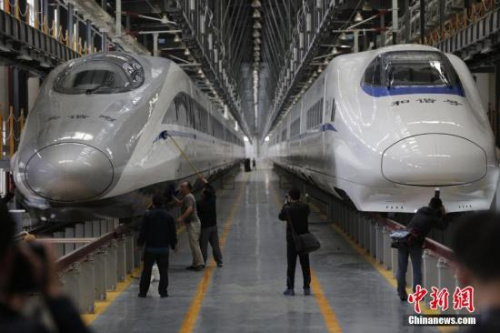These parts of China in the future will be rail-high speed railway construction _ can run 350 km | line | news
 Information diagram. Zhang bin, photo
Information diagram. Zhang bin, photo  "The eight longitudinal and eight lateral" high-speed rail corridor. Beijing, Xinhua Li Jinlei
"The eight longitudinal and eight lateral" high-speed rail corridor. Beijing, Xinhua Li Jinlei  Meng Zhubin made by the information agency, new photo
Meng Zhubin made by the information agency, new photo CNS, Beijing, July 21 (reporter Li Jinlei)-Gao Tiejian much longer in the future? Speed run fast? Where the high iron? Jiangaotie where did the money come from? China's national development and Reform Commission on 20th of the medium-and long-term railway network plan, gives the answer: by 2020 high speed rail to up to 30,000 km; along the dense population urbanization and economic development, through mega-city high-speed train can run 350 km/h; building "eight longitudinal and eight lateral" main; funding channels to encourage capital investment in building the railway.
Gao Tiejian much longer in the future?
--2020 year to up to 30,000 km
Data shows that by the end of 2015, the national railway mileage up to 121,000 km, of which 19,000 kilometers of high speed railway.
Plans of this planning period is 2016-2025 years, and by 2020, the network reached 150,000 km, of which 30,000 kilometers of high speed railway, covering more than 80% of big cities. By 2025, the rail network to reach 175,000 kilometers, about 38,000 km of high speed railway.
According to the planning requirements, built to be modern high-speed rail network. Linking major urban agglomerations, basic connectivity and others more than 500,000 people, the provincial capital cities, formed in large urban centres nationwide, as a fulcrum to the capital city covered around high-speed railway network. Achieve 1-4 hour traffic circle between neighboring cities, city 0.5~2 hours in traffic circles.
Speed run fast?
--Part of the Gao Tieke to run 350 km
After deceleration in 2011 HSR speed became a major focus of attention. According to the plan, part of the future high-speed rail can run 350 km per hour.
"According to local conditions and established construction standards. "Plan proposed, new high-speed rail corridor planning project principles with 250 km/h and above standard (complex and difficult topography and climate conditions can be reduced), of which, along the dense population urbanization and economic development, through metropolitan railway adopted standards of 350 kilometers per hour.
Planning also requires the principle of regional rail link speeds of 250 km/h and the following criteria. Intercity railway principle of 200 kilometers per hour and the following criteria.
Where the high iron?
--"Eight longitudinal and eight lateral" channel of Beijing high iron into
What future will communicate through high-speed rail? According to the plan, the future will be built "eight longitudinal and eight lateral" high-speed channel. "Eight longitudinal" channel for: coastal channel, and Beijing Shanghai channel, and Beijing (Taiwan) channel, and Beijing HA-Beijing Hong Kong and Macao channel, and Hunan channel, and Beijing Kun channel, and package (Silver) sea channel, and blue (West) wide channel; "eight cross" channel for: sui full channel, and jinglan channel, and green silver channel, and bridge channel, and along channel, and Shanghai Kun channel, and HA Yu channel, and wide Kun channel.
Beijing, (app public: cns2012) reporter noted that, as the "eight longitudinal and eight lateral" main building, a large number of cities will have access to high-speed rail brings many dividends.
Xia Yu channel, for example, Xia Yu channel refers to Xiamen, LongYan ~ ~ Ganzhou qianjiang ~ ~ ~ ~ ~ Zhangjiajie in changde, Changsha, Chongqing high-speed railway. With the completion of the high-speed rail line, there are no trains in changde, Zhangjiajie and other cities will benefit from.
Where did the money come from?
--Encourage the participation of social capital construction
Construction of the scale of the high-speed rail network, where did the money come from? Planning, problems such as cracked railway investment and financing reform spirit, market-oriented innovation financing, market access liberalization, foster diversified investment, encourage and support local governments and widely attracted, including civil participation of social capital, and foreign investment in railway construction, forming national investments, a combination of local fundraising, social and financing channels, multi-level, diversified railway investment and financing mode.
Secretary Fei Zhirong 20th the basis of China's national development and Reform Commission said in a press release, the railway construction investment is huge, especially in high-speed railway construction. Railway investments remain at more than 800 billion. Funding sources, including the central budget for investment, mainly railway construction fund, railway construction bonds, and special building Fund also funded with bank financing, local governments and other sources is multi-channel.
Fei Zhirong said that actively encourage social capital investments in the construction of railways. Generally speaking, the existing railways are open to social capital, as well as in respect of land development, and enjoy the same policies, this expanding social capital, including the participation of private capital, foreign direct investment in the railway construction. Through the efforts of all sectors, especially in railway investment and financing system reform deepening, the railway construction funds can be effectively guaranteed. (End)
Responsible editor: Kun Qu SN117
Article keywords:Construction of high-speed railway
I want feedback
Save a Web page
China News Network
未来中国这些地方将通高铁 部分时速可跑350公里|高铁|铁路建设_新闻资讯
 资料图 。张斌 摄
资料图 。张斌 摄  “八纵八横”高铁主通道。中新网记者 李金磊 制
“八纵八横”高铁主通道。中新网记者 李金磊 制  资料图 中新社发 孟祝斌 摄
资料图 中新社发 孟祝斌 摄 中新网北京7月21日电(记者 李金磊)未来高铁建多长?时速跑多快?哪些地方将通高铁?建高铁的钱从哪里来?中国国家发展改革委员会20日公布《中长期铁路网规划》,给出了上述问题的答案:到2020年高铁要达3万公里;沿线人口城镇稠密、经济比较发达、贯通特大城市的高铁时速可跑350公里;构建“八纵八横”主通道;资金来源多渠道,鼓励社会资本投资建设铁路。
未来高铁建多长?
——2020年要达3万公里
数据显示,截至2015年底,全国铁路营业里程达到12.1万公里,其中高速铁路1.9万公里。
这份规划期为2016-2025年的规划提出,到2020年,铁路网规模达到15万公里,其中高速铁路3万公里,覆盖80%以上的大城市。到2025年,铁路网规模达到17.5万公里左右,其中高速铁路3.8万公里左右。
根据规划的要求,要建成现代的高速铁路网。连接主要城市群,基本连接省会城市和其他50万人口以上大中城市,形成以特大城市为中心覆盖全国、以省会城市为支点覆盖周边的高速铁路网。实现相邻大中城市间1~4小时交通圈,城市群内0.5~2小时交通圈。
时速跑多快?
——部分高铁可跑350公里
在2011年经历了减速后,高铁是否提速成为社会关注的一大焦点问题。根据规划,未来部分高铁时速可跑350公里。
“因地制宜、科学确定高速铁路建设标准。”规划明确提出,高速铁路主通道规划新增项目原则采用时速250公里及以上标准(地形地质及气候条件复杂困难地区可以适当降低),其中,沿线人口城镇稠密、经济比较发达、贯通特大城市的铁路可采用时速350公里标准。
规划还要求,区域铁路连接线原则采用时速250公里及以下标准。城际铁路原则采用时速200公里及以下标准。
哪些地方将通高铁?
——“八纵八横”通道 京台高铁纳入
未来哪些地区将会通高铁?根据规划,未来将构建“八纵八横”高速铁路主通道。“八纵”通道为:沿海通道、京沪通道、京港(台)通道、京哈-京港澳通道、呼南通道、京昆通道、包(银)海通道、兰(西)广通道;“八横”通道为:绥满通道、京兰通道、青银通道、陆桥通道、沿江通道、沪昆通道、厦渝通道、广昆通道。
中新网(微信公众号:cns2012)记者注意到,随着“八纵八横”主通道的建立,一大批城市将会享受到高铁带来的诸多红利。
以厦渝通道为例,厦渝通道是指厦门~龙岩~赣州~长沙~常德~张家界~黔江~重庆高速铁路。随着这一高铁线路的建成,目前还没有高铁的常德、张家界等城市将会受益。
钱从哪里来?
——鼓励社会资本参与建设
建设如此大规模的高铁网络,钱从哪里来?规划提出,用改革精神破解铁路投融资等难题,创新市场化融资方式,放宽市场准入,培育多元投资主体,鼓励支持地方政府和广泛吸引包括民间、外资在内的社会资本参与投资铁路建设,形成国家投资、地方筹资、社会融资相结合的多渠道、多层次、多元化铁路投融资模式。
中国国家发展改革委员会基础司司长费志荣20日在新闻发布会上表示,铁路建设投资非常巨大,特别是高速铁路的建设。目前铁路投资保持在8000亿以上。主要资金来源包括中央预算内投资、铁路建设基金、铁路建设债券以及专项建设基金,还有银行的融资、地方政府的出资等,资金来源是多渠道的。
费志荣指出,积极鼓励社会资本投资建设铁路。总的来讲,国家现有的铁路都向社会资本开放,同时在土地综合开发方面,也享受相同的政策,这样更多地扩大社会资本,包括民营资本、外商投资参与到铁路建设中来。通过各方面共同的努力,特别是铁路投融资体制改革的深化,铁路建设资金能够得到有效的保证。(完)
责任编辑:瞿崑 SN117
文章关键词: 高铁 铁路建设
我要反馈
保存网页
中国新闻网